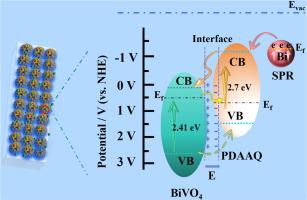Organic semiconductor poly-2,6-diaminoanthraquinone composite and Bi loading synergistically enhance the photoelectrochemical cathodic protection performance of BiVO4
IF 5.7
3区 材料科学
Q2 MATERIALS SCIENCE, MULTIDISCIPLINARY
引用次数: 0
Abstract
BiVO4-based materials have attracted extensive research as advanced photoanode for photogenerated cathodic protection. However, the performance of BiVO4-based photoanodes is greatly hindered by its weak charge migration and positive conduction band potential. Herein, poly-2,6-diaminoanthraquinone (PDAAQ)/Bi was grafted on BiVO4 to improve the separation efficiency of photogenerated carriers and enhance the reducing ability of photogenerated electrons. Studies show that a type II heterojunction can be formed between PDAAQ and BiVO4, which accelerates the separation of photogenerated carriers at the interface. In addition, the Bi monomers anchored on BiVO4/PDAAQ then expand the light absorption range through the surface plasmon resonance effect. Consequently, the obtained BiVO4/PDAAQ/Bi photoanode exhibits a promising photocurrent density of 40 μA·cm-2, while the photoinduced potential drop is 540 mV, which is approximately 1.4 times of BiVO4 materials. These outcomes provide general ideas for the design of organic-inorganic heterozygous systems for achieving eco-friendly corrosion protection.

有机半导体聚2,6-二氨基蒽醌复合材料与Bi负载协同增强了BiVO4的光电阴极保护性能
bivo4基材料作为光生阴极保护的先进光阳极受到了广泛的研究。然而,bivo4基光阳极的性能受到其弱电荷迁移和正导带电位的极大阻碍。本文将聚2,6-二氨基蒽醌(PDAAQ)/Bi接枝于BiVO4上,以提高光生载子的分离效率,增强光生电子的还原能力。研究表明,PDAAQ与BiVO4之间可形成II型异质结,加速了光生载流子在界面处的分离。此外,锚定在BiVO4/PDAAQ上的Bi单体通过表面等离子体共振效应扩大了光吸收范围。所得BiVO4/PDAAQ/Bi光阳极光电流密度为40 μA·cm-2,光致电位降为540 mV,约为BiVO4材料的1.4倍。这些结果为设计有机-无机杂合体系以实现生态友好的防腐提供了一般思路。
本文章由计算机程序翻译,如有差异,请以英文原文为准。
求助全文
约1分钟内获得全文
求助全文
来源期刊

Materials Research Bulletin
工程技术-材料科学:综合
CiteScore
9.80
自引率
5.60%
发文量
372
审稿时长
42 days
期刊介绍:
Materials Research Bulletin is an international journal reporting high-impact research on processing-structure-property relationships in functional materials and nanomaterials with interesting electronic, magnetic, optical, thermal, mechanical or catalytic properties. Papers purely on thermodynamics or theoretical calculations (e.g., density functional theory) do not fall within the scope of the journal unless they also demonstrate a clear link to physical properties. Topics covered include functional materials (e.g., dielectrics, pyroelectrics, piezoelectrics, ferroelectrics, relaxors, thermoelectrics, etc.); electrochemistry and solid-state ionics (e.g., photovoltaics, batteries, sensors, and fuel cells); nanomaterials, graphene, and nanocomposites; luminescence and photocatalysis; crystal-structure and defect-structure analysis; novel electronics; non-crystalline solids; flexible electronics; protein-material interactions; and polymeric ion-exchange membranes.
 求助内容:
求助内容: 应助结果提醒方式:
应助结果提醒方式:


